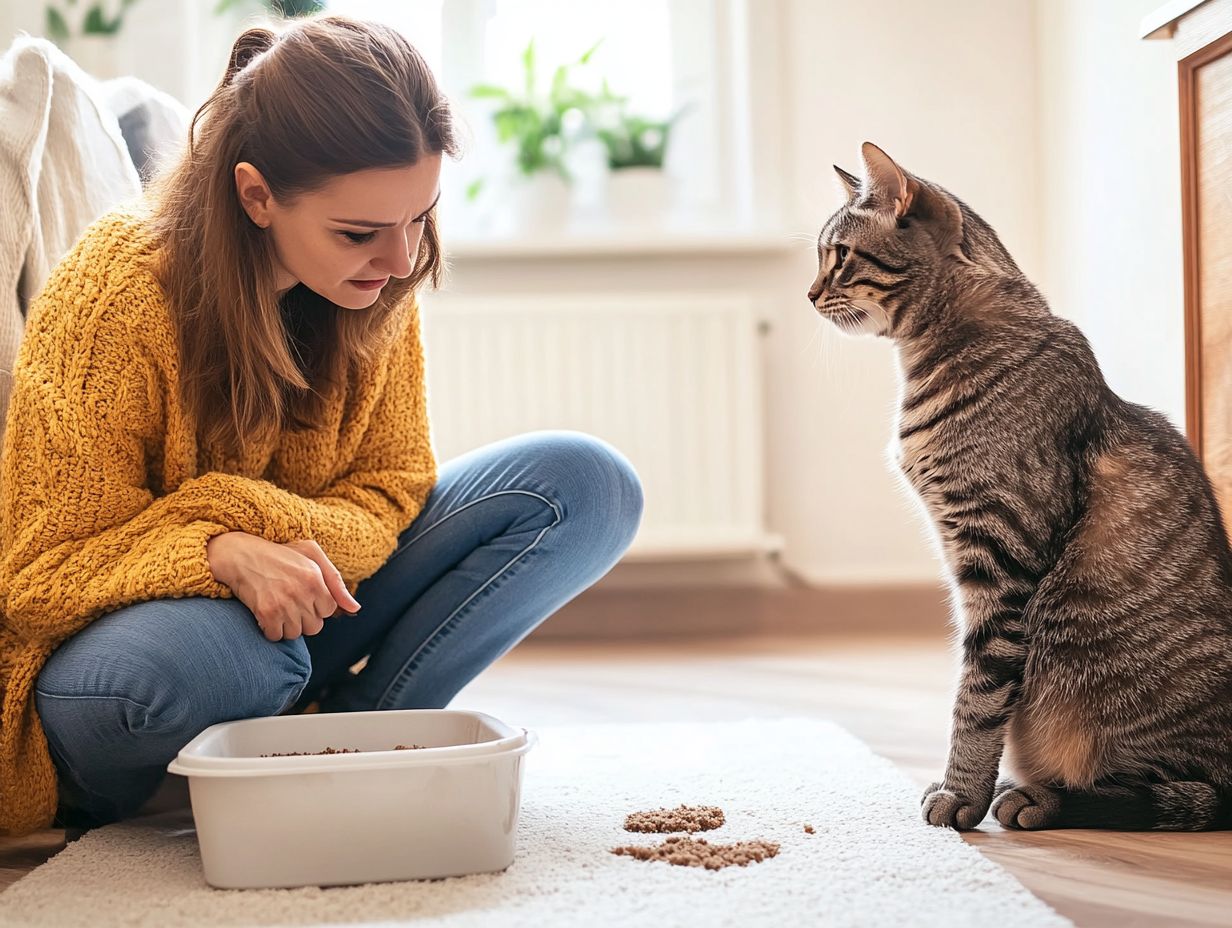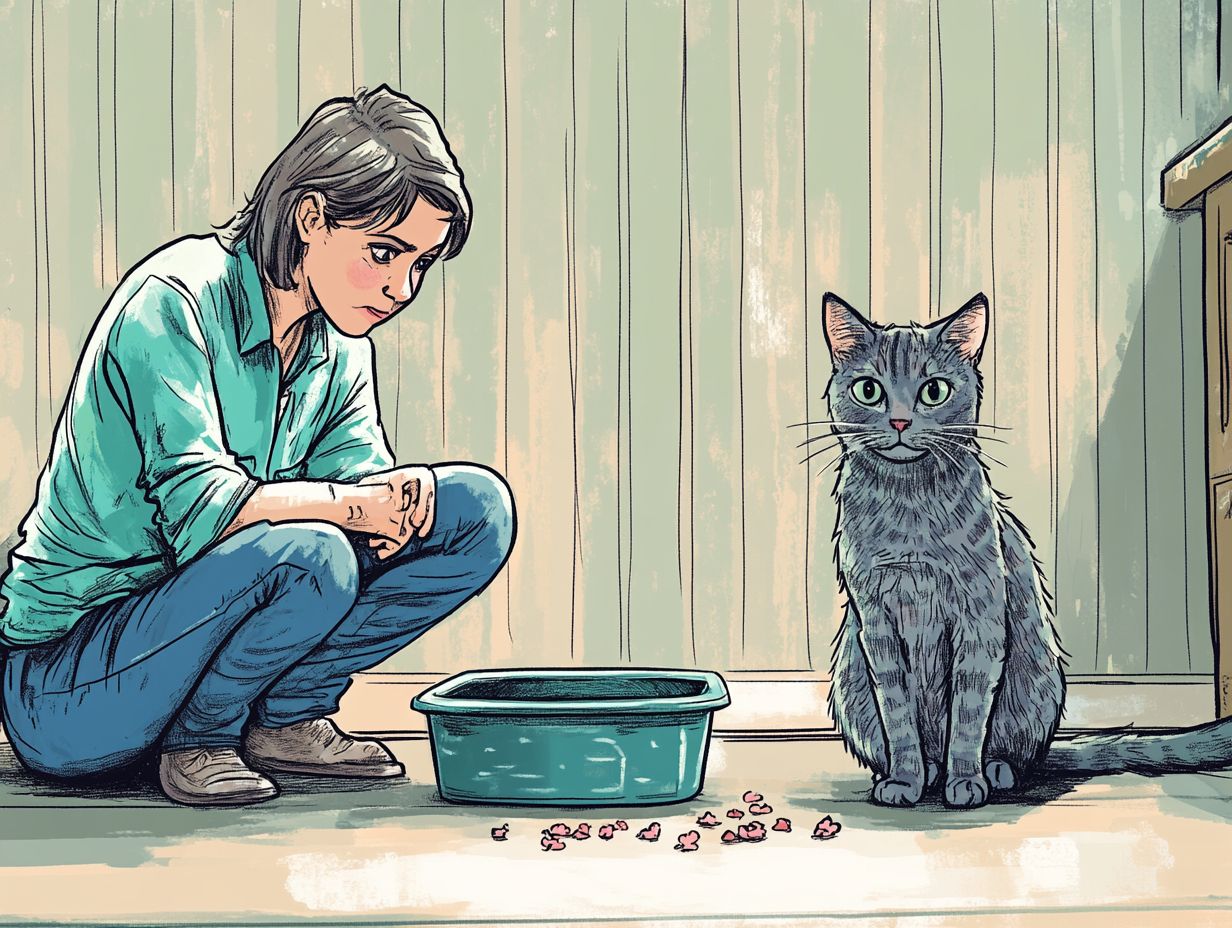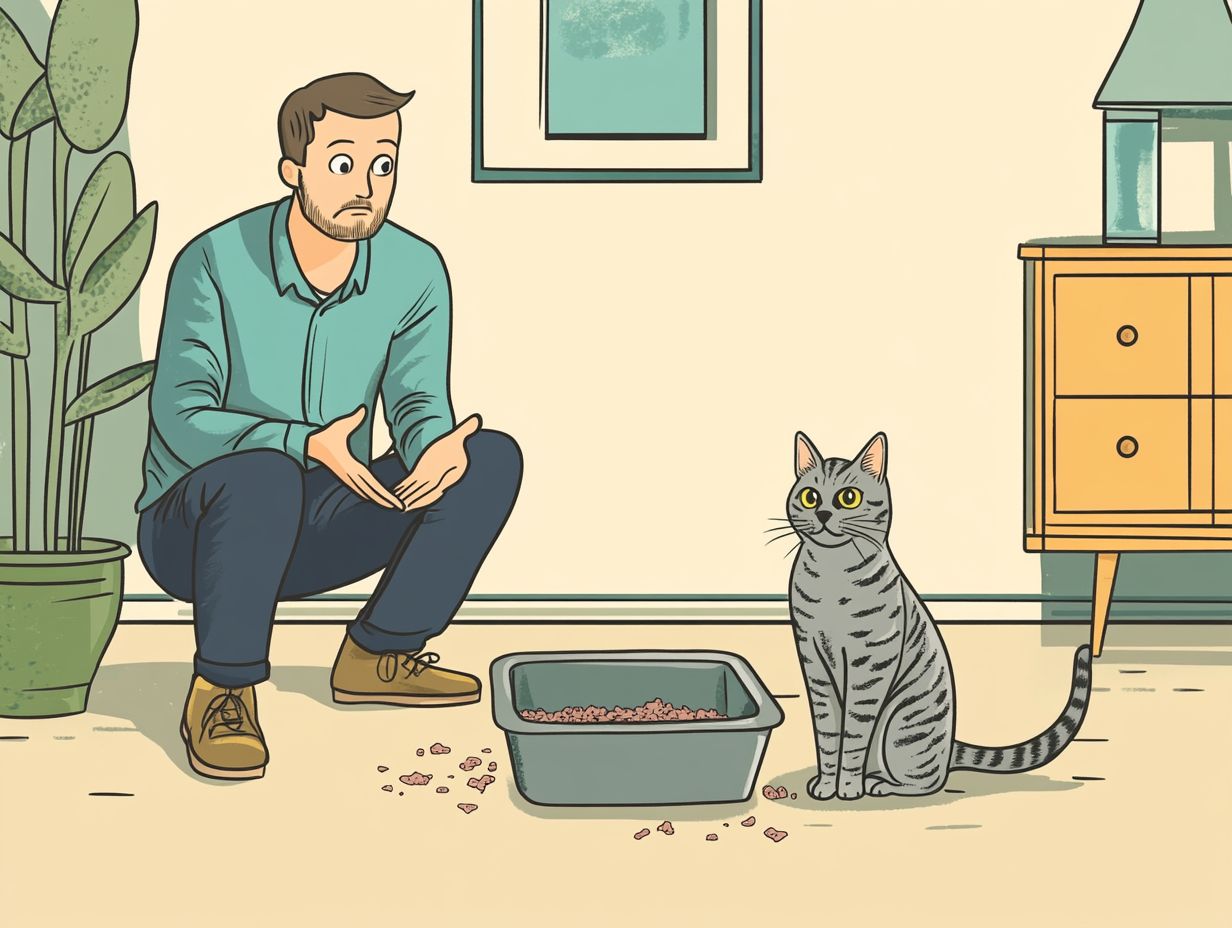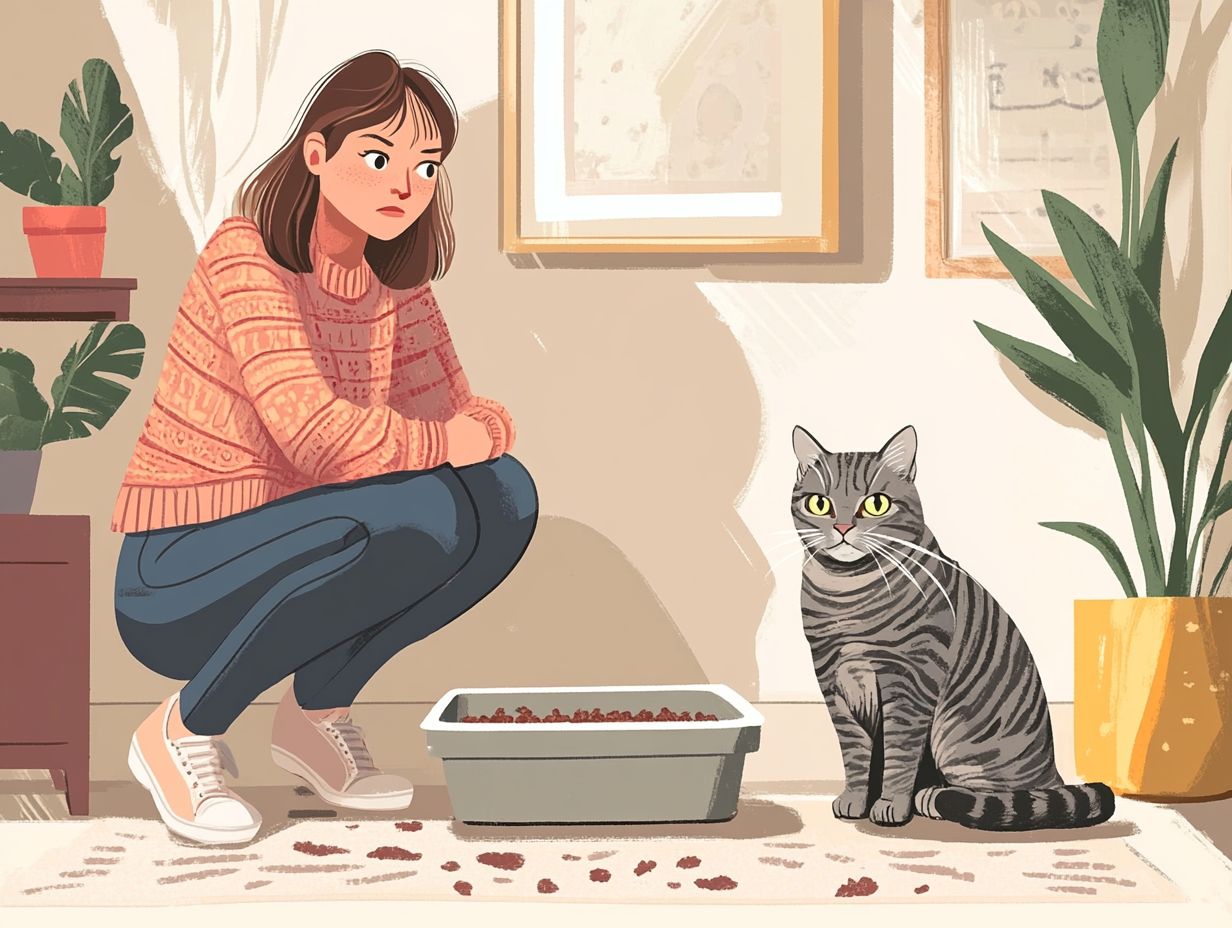If you’ve found your feline friend leaving surprises outside the litter box, you’re not alone.
Many cat owners encounter this puzzling behavior, which can stem from various issues like medical problems, stress, anxiety, or even simple litter box preferences.
Understanding the reasons behind this can help you manage and address the situation effectively.
This article explores the common causes of litter box aversion, practical solutions to remedy the problem, and what actions to avoid.
Your cat’s comfort and well-being are just a read away!
Key Takeaways:

- Make sure to address any potential medical issues that may be causing your cat to poop outside the litter box.
- Reduce stress and anxiety in your cat by creating a comfortable and consistent environment, such as a quiet space, and providing multiple litter boxes to ensure comfort and manage territory issues.
- Use positive reinforcement and seek professional help if needed, but never punish or give up on your cat for this behavior.
Why is My Cat Pooping Outside the Litter Box?
Several reasons can explain why cats may choose to poop outside the litter box, including underlying medical issues like arthritis or gastrointestinal problems, stress and anxiety, and individual litter box preferences. Understanding these factors is essential, as they can indicate possible health problems, behavioral changes, or dissatisfaction with their environment.
Consulting a veterinarian can help identify gastrointestinal issues or potential injuries based on these behaviors, allowing for early treatment and helping to restore the cat’s healthy habits and comfort in their home. Additionally, resources from the Cornell Feline Health Center can provide valuable insights into managing these health concerns.
1. Medical Issues
Medical issues can often be a primary reason for cats pooping outside their litter box, and it is crucial to address these concerns with a veterinarian promptly to prevent further complications such as diabetes, kidney disease, and possible memory problems as a cat ages.
Health problems may include gastrointestinal issues that cause discomfort and alter bathroom habits, as well as more serious conditions like diabetes, kidney disease, or even cognitive dysfunction, which can significantly affect a cat’s quality of life.
Owners should watch for signs such as straining, lethargy, or drinking more water than usual, as these may indicate underlying issues that necessitate medical attention and thorough understanding of their pet’s health. Consulting a veterinarian is essential in these circumstances, as obtaining an accurate diagnosis and developing an appropriate treatment plan tailored to the specific cat is vital for ensuring their well-being.
2. Stress or Anxiety
Stress or anxiety can lead a cat to change its behavior, resulting in avoidance of the litter box and inappropriate urination or defecation. Various changes in a cat’s environment, such as the introduction of new pets, alterations in household structure, or even the death of a family member, can trigger feelings of anxiety and insecurity. Consulting a behaviorist might be beneficial in these situations.
Additionally, loud noises from renovations or the arrival of new family members can serve as stressors that owners should be mindful of. To help alleviate this issue, owners may consider using Feliway, a synthetic pheromone designed to create a calmer environment, or playing soft music to help soothe their pet. Consulting a behaviorist who can provide tailored coping strategies may also be beneficial.
Both options may assist in restoring a cat’s mental well-being and encouraging proper litter box use once again.
3. Litter Box Preferences
Litter box preferences are crucial factors that can influence whether a cat will consistently use the litter box or choose other locations to relieve itself. Several elements determine a cat’s litter box preferences, such as litter type and location:
- Consider different litter types, such as clumping vs. non-clumping, and how they affect your cat’s behavior.
- Choose a litter type based on your cat’s preferences; they may prefer finer textures or specific scents.
- Ensure the litter box location is quiet, accessible, and private, away from noisy areas or high traffic.
In conclusion, understanding and addressing the reasons for your cat’s litter box aversion is vital for their comfort and well-being. By observing signs of medical issues, managing stress, and catering to your cat’s litter preferences, you can help ensure a happy and healthy home for your feline companion.
- Type of Litter: Cats may prefer clumping litter, which forms solid clumps for easy cleaning and helps control odors, versus non-clumping litter, which absorbs moisture but doesn’t form clumps. A soft texture can be more appealing for many cats.
- Texture of the Litter: Cats generally prefer litter that resembles dirt or soil. For outdoor cats, a softer litter may be more appealing. The cleanliness and depth of the litter can also influence their preference.
- Cleanliness of the Box: A dirty litter box can deter even the most easy-going cats from using it. Regular maintenance and daily scooping are crucial for keeping the litter box appealing. Aim for at least one litter box per cat, plus one extra, for optimal hygiene.
- Scent of the Litter: Most cats prefer unscented litters over those with strong artificial fragrances, as these can trigger negative reactions.
Balancing these factors can lead to reducing the likelihood of inappropriate elimination behaviors. For more information, check out this article on why cats may poop outside the litter box.
4. Territory Marking
Territory marking is a natural behavior among cats. They may eliminate outside their litter box to assert dominance if they feel their territory is threatened. This serves as both a visual and olfactory marker, signaling to others that a space is claimed.
In multi-pet households, the social hierarchy can become complicated. For instance, when a new pet is introduced, the existing cat may feel an urgent need to mark its territory.
This behavior reflects a cat’s territorial needs and their psychological state, including feelings of anxiety or insecurity, which can negatively impact their health.
5. Changes in Routine or Environment

Changes in a cat’s routine or environment can trigger anxiety, leading them to stop using their litter box. Such changes can include moving to a new house, welcoming a new family member, or any situation that disrupts their comfort zone.
Cats thrive on consistency, and when they perceive stability is threatened, they may exhibit defensive behaviors or even regression. To minimize stress, maintain routine, including regular feeding times, access to familiar toys, and a designated quiet area.
By creating a comforting environment, owners can help their pets adjust more easily to these changes.
How to Fix the Problem?
The most effective way to prevent a cat from pooping outside the litter box is to identify and address any underlying health issues, reduce stress, and ensure the litter box is arranged according to the cat’s preferences, such as location and type of litter.
1. Address Any Medical Issues
The first step in addressing the issue of a cat pooping outside the litter box is to consult a veterinarian to identify any underlying medical problems. This not only helps determine if the cat has issues like urinary tract infections, gastrointestinal disorders, arthritis, cognitive dysfunction, or cancer, but also facilitates immediate, medically necessary solutions.
Behavioral issues are often linked to physical problems or pain, highlighting the importance of professional guidance. By conducting tests and evaluations, veterinarians can support owners in fostering a harmonious household and addressing their cat’s needs.
2. Reduce Stress and Anxiety
Reducing your cat’s stress and anxiety can significantly improve their behavior and increase their likelihood of using the litter box consistently. The most crucial step is to provide a tranquil environment, which can help alleviate fears and manage stress levels.
One effective way to create this environment is by using calming products, like Feliway, which releases natural pheromones. Additionally, offering comfort through cozy hiding spots or blankets ensures they have safe places to retreat when feeling overwhelmed.
3. Provide Multiple Litter Boxes
As a best practice, aim for one litter box per cat plus one extra to reduce territorial disputes and encourage proper usage.
Additionally, ensure that each box is kept clean and placed in a quiet, easily accessible area to promote positive experiences.
In conclusion, regularly assess your cat’s litter preferences and environment to promote a happy and healthy litter box experience.
Placing multiple litter boxes throughout your home helps ensure your cat uses the litter boxes regularly, especially if you have other pets. This practice aligns with your cat’s natural instincts and helps to reduce territorial conflicts that may arise among multiple cats in the same household.
Cats are inherently territorial animals, and providing multiple litter boxes ensures that each cat has its own designated space to relieve itself when needed. Positioning the boxes in different locations—such as quiet areas, near their favorite sleeping spots, or close to where your pets frequently gather—can also encourage regular use and prevent accidents.
A general guideline is to have one litter box per cat, plus one extra, which aligns with expert recommendations to prevent territorial disputes and create a stress-free environment for your pets.
4. Clean the Litter Box Regularly
Regular cleaning of the litter box is essential for maintaining a hygienic environment that encourages cats to use it and prevents accidents elsewhere in the home. A clean litter box makes it more inviting for your cat, which is naturally a clean animal and can be quite particular about its bathroom habits.
The litter box should be scooped daily, which includes removing clumps and waste, and thoroughly cleaned weekly to prevent the buildup of odors and bacteria. Establishing a consistent cleaning schedule significantly increases the likelihood that a caregiver’s cat will use the box, reducing anxiety for both the cat and the owner. Using a litter scoop can make daily maintenance easier.
A fresh, clean environment communicates to the cat that this is an acceptable and safe place to relieve itself.
5. Try Different Types of Litter

By experimenting with different types of litter, such as unscented or clumping options, you can determine which one best suits your cat’s preferences and needs, thereby encouraging regular use of the litter box. Cats are highly sensitive creatures, and the litter you choose can significantly impact their comfort level and overall behavior.
Factors such as clumping versus non-clumping litter can influence cleaning ease and cleanliness:
- Clumping litter: Easier to clean, holds odors well.
- Non-clumping litter: May be cheaper, softer texture.
Additionally, unscented litter may be favored by cats that are sensitive to strong odors. Daily maintenance and thorough cleaning are essential for keeping the litter box inviting.
By exploring these various options, you can create a more pleasant litter box experience for your cat, which is likely to lead to increased usage and reduce accidents.
6. Create a Comfortable Environment
Creating a comfortable environment is an effective way to prevent litter box aversion and accidents in cats, as it encourages proper litter box use. By customizing their surroundings to meet their cats’ needs, owners can significantly impact their pets’ comfort and behavior.
Cat owners should start by providing cozy hiding spots, such as a soft pet bed or a cardboard box with a blanket, in a quiet corner or alcove where the cat feels safe to retreat. It is also important to minimize loud noises and sudden changes in the household, as these environmental stressors can contribute to anxiety and territorial behavior.
Additionally, placing multiple litter boxes in easily accessible locations can help reduce stress and promote proper litter box use. A relaxed environment fosters a sense of safety for the feline, which enhances comfort and encourages desirable behavior.
7. Use Positive Reinforcement
Utilizing positive reinforcement techniques is an effective way to train your cat to use the litter box, thereby reducing the likelihood of accidents. Positive reinforcement fosters trust and creates a less stressful environment for both the pet and the owner.
For instance, offering chicken-flavored treats and affection immediately after your cat uses the litter box can encourage repeat behavior. Other effective methods include clicker training or incorporating a favorite toy, ensuring the litter box remains a positive place.
If issues continue, consulting a behaviorist who specializes in feline behavior may prove beneficial, especially in managing anxiety or stress-related behavior.
In conclusion, observing your cat’s behavior and adapting your litter box setup accordingly is essential for ensuring their comfort and encouraging regular use. By following these practical tips, you can create a litter box environment that your cat will appreciate.
If the problem persists despite your efforts, seeking professional assistance from a veterinarian or behaviorist can provide valuable insights and tailored solutions for your cat’s situation. They can diagnose any underlying medical issues that may be contributing to the litter box problems, such as urinary tract infections, gastrointestinal issues, or problems with behavior. For more information on common litter box issues, check out Why is My Cat Pooping Outside the Litter Box? Reasons and Tips to Fix It.
Additionally, they will introduce specific training and behavior modification techniques that align with your cat’s unique personality. Understanding the habits and tendencies of your feline companion is crucial, and professionals have the expertise to help mitigate environmental stressors.
Utilizing their knowledge can not only address the immediate issue but also foster a healthier relationship between you and your pet, ultimately enhancing both of your well-being. Consulting reputable sources like the Cornell Feline Health Center or the American Animal Hospital Association may provide additional insights into managing behavioral or health-related concerns.
What Not to Do?
Understanding what not to do when addressing a cat’s inappropriate elimination is as crucial as knowing the appropriate actions to take. Certain behaviors can exacerbate the issue and be harmful to the cat.
1. Punish Your Cat
- Punishing your cat for pooping outside the litter box can lead to increased stress and confusion, potentially worsening the problem.
- Harsh treatment can instill fear in your feline friend, leading to behavioral issues or anxiety more difficult to address.
- Cats may associate their litter habits with punishment, leading them to avoid using the litter box altogether.
This highlights the importance of using positive reinforcement methods, such as rewarding your cat with treats or affection when they use the litter box correctly. By fostering a supportive environment, you can boost your cat’s confidence, ultimately resulting in a happier and healthier companion.
2. Ignore the Problem

Neglecting the issue of your cat pooping outside the litter box can lead to escalating behavioral problems and worsen any underlying medical conditions. Addressing this issue promptly is crucial, as persistent neglect may cause your cat to develop anxiety, engage in territorial marking behavior (i.e., cats urinating to mark their territory), or become increasingly reclusive.
Additionally, inaction can result in an unsanitary living environment, posing a public health concern for everyone in the household. If the litter box problems remain unresolved, the bond between humans and the cat may become strained, as owners grow increasingly frustrated by the need to clean up messes in unwanted locations.
3. Give Up on Your Cat
Refusing to care for a cat due to litter box problems can lead to heartbreaking emotional suffering for both the owner and the cat. The bond between a cat and its owner is significant and can withstand litter box challenges with the right mindset and approach. Engaging in open discussions and seeking professional guidance can provide the necessary support and direction.
Rather than viewing these issues as insurmountable obstacles, they can be seen as opportunities for growth and connection. When cat owners remain determined and engage in open discussions about the problems, they create a supportive environment that fosters trust.
Pets are incredibly perceptive, and when they sense that they are loved and cared for, they may be more inclined to change their behavior. Addressing these challenges together can resolve the immediate issue and strengthen the relationship in meaningful ways for both parties.
Frequently Asked Questions
Why is My Cat Pooping Outside the Litter Box?
To effectively manage litter box issues, consider the following actionable steps:
- Consult a veterinarian to rule out medical issues.
- Experiment with different types of litter, such as clumping or non-clumping, to find what your cat prefers.
- Provide one litter box per cat plus one extra for optimal access.
- Maintain a clean litter box environment by scooping daily and changing litter regularly.
In conclusion, addressing litter box issues promptly is essential for the well-being of both you and your cat. Taking immediate action by consulting a vet or exploring different types of litter can lead to a more harmonious living situation.
There can be several reasons why your cat is pooping outside the litter box, including medical, behavioral, or environmental factors. It’s essential to understand these areas to find effective solutions. For more information on cat health, you can refer to trusted resources like the American Veterinary Medical Association (AVMA).
What are some medical reasons for a cat to poop outside the litter box?
Medical issues such as urinary tract infections, constipation, or arthritis can cause your cat discomfort and make it difficult for them to use the litter box. Always consult with a veterinarian to rule out these conditions.
How does stress or anxiety contribute to a cat pooping outside the litter box?
Cats can be sensitive to changes in their environment or routine. Specific examples of stressors include:
- Introducing new pets.
- Moving homes.
- Changes in household members.
These stressors can lead to anxiety, causing them to avoid using the litter box. Monitoring these changes is crucial for finding a solution. Referencing behavioral experts can provide further understanding.
Are there any environmental factors that may cause a cat to poop outside the litter box?
Yes, factors such as:
- A dirty or inaccessible litter box.
- Sharing a litter box with another cat.
- A location that is too noisy or busy.
To maintain a clean litter box, scoop daily and change the litter regularly. It is generally recommended to have one litter box per cat plus one extra, and boxes should be located in quiet areas away from food and water bowls.
What are some tips to help fix this issue?
- Schedule a vet visit to rule out health issues.
- Keep litter boxes clean by scooping daily and changing litter regularly.
- Experiment with different litter types (clumping vs. non-clumping; clay vs. biodegradable) to find the one your cat prefers.
- Identify and eliminate any stressors in their environment.
- Make sure the litter box is always clean and in a quiet and easily accessible area.
For those searching for the best cat litter for litter box issues, try different options to see what works best for your cat.
When should I seek help from a veterinarian?
If your cat continues to poop outside the litter box despite your efforts to fix the issue, it may be time to consult with a veterinarian. They can help determine if there is an underlying medical issue or provide further advice on how to address the problem.
In conclusion, understanding the reasons behind a cat’s behavior is essential. Address medical, behavioral, and environmental factors, maintain a consistent routine, and be observant of your cat’s behavior for the best outcomes.